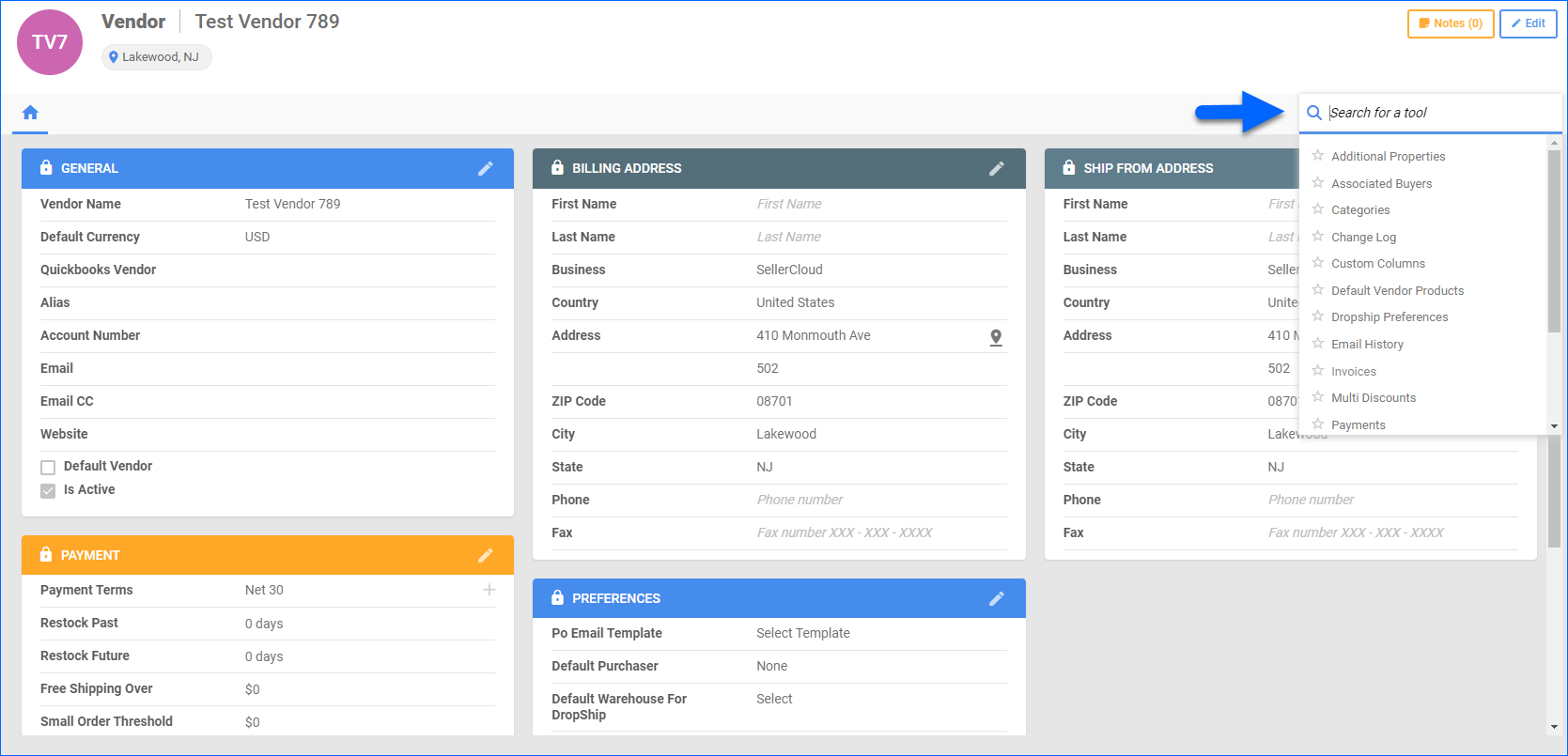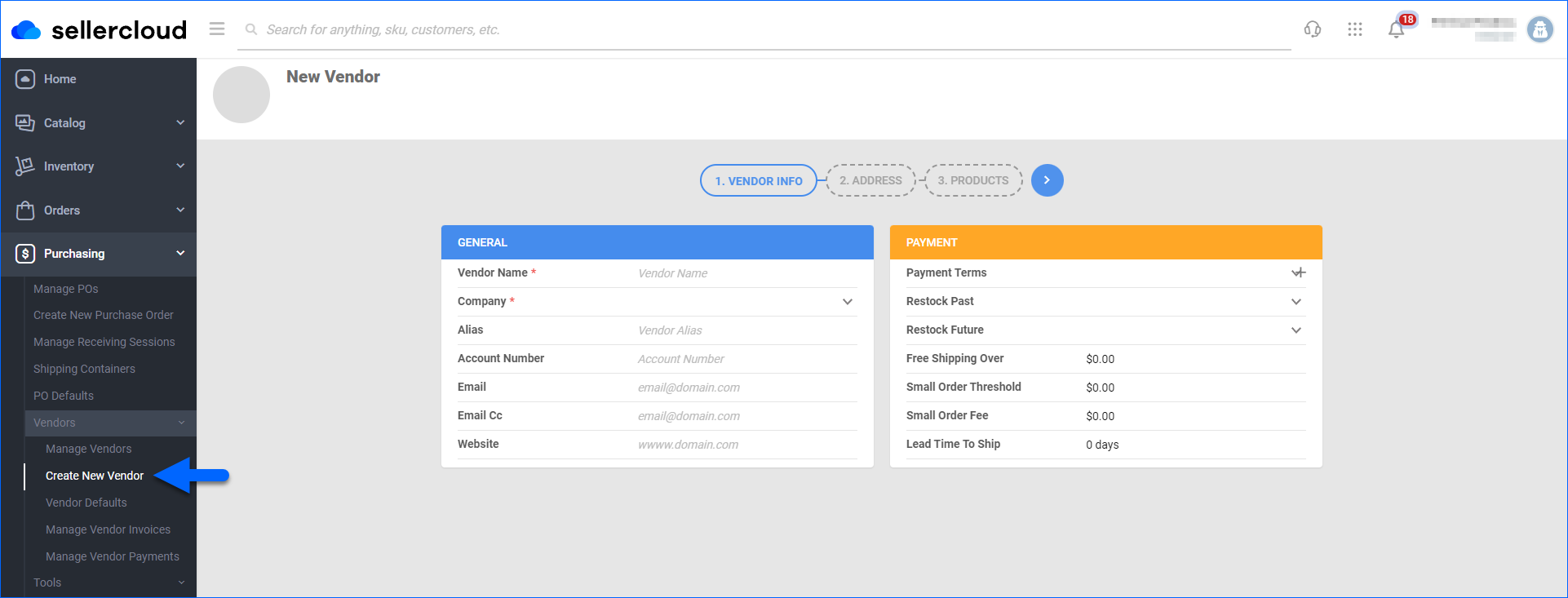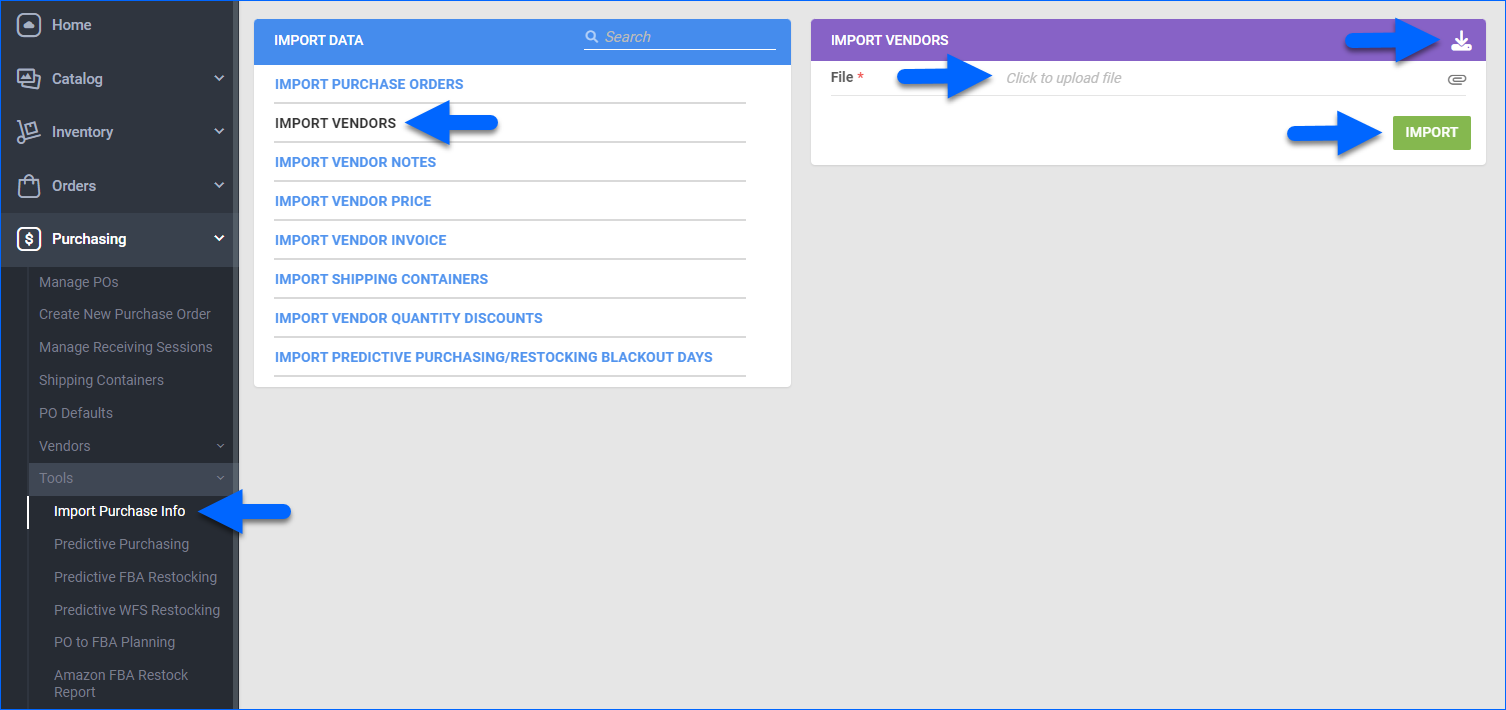Overview
In this article, you will learn how to add vendor profiles in Sellercloud. These profiles can then be used to create Purchase Orders, Dropship Orders, and apply promotions or discounts. Once a vendor is created in Sellercloud, it is recommended to configure its Properties and preferences to ensure consistent and efficient operations. You can also apply Vendor Defaults globally to all vendors within your account and assign a Default Vendor to your products – your primary or most frequently used supplier.
Create Vendors
If a vendor is intended to apply across all companies within your account, you don’t need to specify a company when creating it. However, if the vendor should be limited to a specific company, you must designate the company when setting it up.
Individually
There are two ways to create a new vendor:
- Navigate to Purchasing > Vendors.
- Click Create New Vendor; or
- Manage Vendors, and select the Add Vendor action.
- Fill in the Vendor Info, Address, and add Products.
- You can use the QuickBooks Vendor field if you need to map a vendor to a vendor with a different name in QuickBooks. For example, if you have to separate a vendor for dropship and wholesale in Sellercloud, you can map them to a single vendor in QuickBooks. Quickbridge will use this field when exporting to QuickBooks.
The QuickBook Vendor field will only display when the Client Setting Enable QuickBooks WorkFlow is enabled.
- If applicable, set a small order amount and fee. For example, a fee of $4 can be added to a purchase order total when a single PO from this vendor subtotals to 50$ or less. The small order fee will be added as a line item on the PO total.
- You can use the QuickBooks Vendor field if you need to map a vendor to a vendor with a different name in QuickBooks. For example, if you have to separate a vendor for dropship and wholesale in Sellercloud, you can map them to a single vendor in QuickBooks. Quickbridge will use this field when exporting to QuickBooks.
- Once you create the new vendor, you will be directed to the Vendor Properties page.

You can edit the vendor info and configure Email Templates by using the Pencil icon at the top of each respective panel, or access the Toolbox to adjust Dropship Preferences, add additional Products, view Email History, and more.
Bulk
To create new vendors in bulk:
- Go to the Import Vendors page:
- Click the Download icon.
- Select your desired format and fill out the template.
- Upload the file and click Import.
- A Queued Job will be created. To access it, click the link at the bottom of the page.

Required Columns
The following columns are required:
| REQUIRED COLUMN | DESCRIPTION |
| Vendor | The vendor’s name. |
| The vendor’s contact email address. | |
| Account No | Your account number with the vendor. |
| BillingContactFirstName | The first name of the person responsible for billing purposes for the vendor. |
| BillingContactLastName | The last name of the person responsible for billing purposes for the vendor. |
| BillingAddress 1 | The first line of the street address for the vendor’s billing contact. |
| BillingAddress 2 | The second line of the street address for the vendor’s billing contact (if applicable). |
| BillingCity | The city where the vendor’s billing contact is located. |
| BillingState | The state where the vendor’s billing contact is located. |
| BillingZipCode | The zip code of the vendor’s billing contact. |
| BillingPhone | The phone number of the vendor’s billing contact. |
| BillingFax | The fax number of the vendor’s billing contact. |
Optional Columns
The following columns are optional:
| OPTIONAL COLUMN | DESCRIPTION |
| IsDefault | True or False. Enter True to configure this vendor as a default vendor. |
| ShippingContactFirstName | The first name of the primary contact for shipments. |
| ShippingContactLastName | The last name of the primary contact for shipments. |
| ShippingAddress 1 | The first line of the street address where shipments for this vendor originate from. |
| ShippingAddress 2 | The second line of the street address where shipments for this vendor originate from (if applicable). |
| ShippingCity | The city where shipments for this vendor originate from. |
| ShippingState | The state where shipments for this vendor originate from. |
| ShippingZipCode | The zip code of the location. |
| ShippingPhone | The phone number of the person or department responsible for shipping. |
| ShippingFax | The fax number for the person or department responsible for shipping. |
| DefaultWarehouseID | The ID of the vendor’s default Ship From Warehouse. |
| POMultiDiscountTreatAsDiscount | True or False. Set to True to show Multi-Discounts applied as the Multi Discount Total in the Purchase Orders’ Total panel. |
| VendorAlias | Another name for the same vendor. |
| EmailAddressCC | When emailing the vendor, you will CC this email address. |
| PaymentTerm | Add any Payment Terms that reflect the agreements between you and your vendor for when payments are due. |
| DefaultPurchaser | The ID or username of the Sellercloud employee who is the default purchaser from the vendor. |
| PredictivePastDays | The number of days with data that will be analyzed for predictive purposes. |
| PredictiveFutureDays | The number of days in the future that predictions are being made for. |
| FreeShippingAmount | The minimum order amount that qualifies for free shipping. |
| SmallOrderAmount | The maximum order amount that is considered a small order. |
| SmallOrderFee | The fee charged for small orders that fall below the small order amount threshold. |
| LeadTimeToShipFromSite | The number of days it takes for products to be shipped from your warehouse or site to your customers. |
| LeadTimeToShipFromVendor | The number of days it takes for products to be shipped from the vendor’s warehouse or site. Used in Predictive Purchasing. |
| EnableSendMultiplePOInOneEmail | True or False. Set to True to allow multiple POs to be sent via one email. |
| DisplayPOOnProductDashBoardPanel | True or False. If you set this column to True, Purchase Orders from this vendor will show up on products’ Toolbox > Purchasing. |
| DonotCountInventoryForDropShipPO | True or False. Whether to count inventory for dropship purchase orders or not. Enable it to ensure your inventory count isn’t impacted or adjusted for pending or actual drop shipped orders. |
| POExportFormat | The format in which you export Purchase Orders. You can select from a few choices and even click Custom and use plugins here. |

